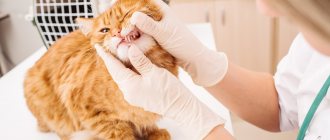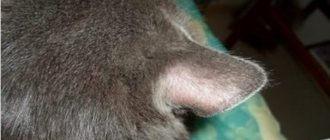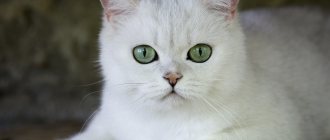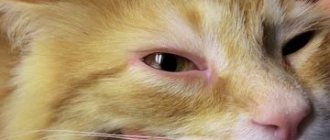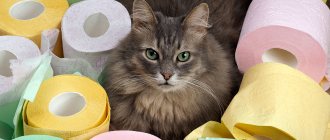Rickets in kittens is a growing disease. It occurs due to metabolic disorders and a lack of vitamins vital for the healthy and full development of the body. This is a serious and dangerous disease that can lead to serious functional impairment.
It affects not only the kitten’s skeletal system, but also generally affects the development of its body. That is why treatment of rickets must be comprehensive and professional. Here you can find out all the most important things about the causes of rickets in kittens, its signs and methods of treatment.
See this article:
Causes of the disease Signs of rickets in kittens How to make a diagnosis? Treatment of rickets What should be the diet for rickets? Disease prevention
Causes of rickets
This pathology is of two types:
- The congenital type develops in kittens as a result of poor quality and unbalanced nutrition of their mother.
- The acquired form appears in those babies who are not well cared for. Often the disease develops against the background of long-term viral and chronic pathologies, diseases of the digestive organs, liver or kidneys.
The cause of the disease is also insufficient intake of vitamin D into the animal’s body, a lack of essential vitamins - phosphorus, magnesium, potassium, calcium.
A congenital disease can appear immediately after the birth of a kitten. It is provoked by:
- premature mating of the cat or her illness at this moment;
- exhaustion of the animal or the presence of genetic abnormalities;
- insufficient amount of taurine contained in the body of a pregnant female;
- lack of protein in the diet;
- mating with cats of related origin (usually many sick kittens are born in such a litter);
- frequent matings;
- lack of vitamins and minerals in a cat during pregnancy.
Factors that provoke the development of the acquired form of rickets in children:
- lack of sun and lack of fresh air;
- feeding with low-quality breast milk substitutes;
- early weaning from the mother and the same early transfer of the kitten to solid food;
- lack of vitamins and minerals in the feed;
- malabsorption of nutrients.
Signs of rickets in kittens
How can you tell if a kitten has rickets soon after it is born? In fact, there are no particular difficulties with this. If the pathology is congenital, then the appearance of the animal is sad.
- Babies have strangely curved and seemingly “twisted” paws.
- The kittens are constantly squeaking and literally screaming. This happens because they are simply in pain.
- Pets with rickets are far behind their healthy relatives in development; their eyes open very late. The claws of these animals are soft, sometimes they literally peel apart before our eyes.
If you see signs of rickets in a kitten, do not rush to immediately take him to the veterinarian. Take his mother (and all his brothers and sisters) with you. If a baby who EATS only mother's milk has problems with a lack of vitamin D and Ca, then the cat's health is probably not all right. In a word, the help of a specialist will not hurt all your pets.
Is vitamin D always to blame?
Almost all owners are inclined to believe that rickets can develop solely due to a lack of vitamin D. To replenish it, they begin to give the animals fish oil in large quantities. In this case, the vitamin deficiency can actually be replenished (sometimes there is an excess of it in the body), but the disease remains. Moreover, it begins to imperceptibly undermine the baby’s health, sometimes remaining in his body throughout his life.
Rickets can also develop due to calcium deficiency. No matter how much vitamin D is supplied, bone tissue does not grow enough due to calcium deficiency. This is how the symptoms of rickets arise. If there is too much phosphorus in the blood, it begins to block the absorption of calcium, causing the body to suffer.
Symptoms of rickets in adult cats
An experienced specialist will easily notice a reduced degree of bone mineralization on an x-ray. In addition, X-rays clearly show the destruction of bone growth zones. Because of this, in advanced cases, young animals, even with a satisfactory result of treatment, will no longer be able to reach the same size as their healthy relatives.
Visual examination shows similar results:
- Strange bending of the limbs . In severe cases of rickets or osteoporosis, the cat looks like an “old sea wolf”, as its paws are strongly arched.
- Chest deformity. This is due to the fact that the ribs, being quite thin and lamellar bones, are the first to be hit by a lack of calcium in the body.
- Scoliosis or lordosis. Simply put, a sick cat's spine is noticeably deformed.
- Sagging belly. Associated with both deformities of the spinal column and impaired rigidity (contractility) of the abdominal muscle tissue. The fact is that normal muscle functioning also directly depends on the normal amount of free calcium in the blood.
Symptoms of the disease
Typically, a breeder identifies rickets in a small kitten by the following signs:
- significant lag in growth and development compared to other kittens in the litter;
- lack of communication with his fellows, prefers to sit unnoticed in the corner;
- conditioned reactions are usually slowed down;
- the back of the animal sags, and the belly increases significantly;
- the spine and legs are noticeably curved;
- the gait is unsteady and uncertain, sometimes with a noticeable limp;
- no change of teeth is observed;
- joints are usually increased in size;
- the ribs are flattened.
Sometimes the animal develops diarrhea, muscle spasms, shortness of breath and a severe cough. These are secondary signs indicating the development of this pathology.
At what age does the disease appear?
Rickets can manifest itself between the ages of 2 weeks and up to six months. During this time, babies need to be examined daily. It is necessary to closely monitor the growth of kittens, since even a slight lag from normal indicators indicates the development of very severe pathologies. As the kitten gets older, the symptomatic picture becomes more pronounced and intense. It can be extremely difficult to control the disease in older age.
Consequences of rickets
Rickets is a dangerous lesion of bone tissue in the form of thinning and curvature. In addition, pathology causes disturbances and disorders in the functioning of all organs and systems. The consequences of the disease are:
- subsequent gradual curvature and irreversible thinning of the bones, as a result of which the cat remains disabled for life;
- chronic inflammation and destruction of cartilage and tissue;
- disruption of the liver and the entire gastrointestinal tract;
- reducing to a minimum the process of absorption of vitamins and microelements, causing the pet to lose a lot of weight and constantly get sick;
- development of severe convulsive seizures;
- development of oxygen starvation.
Further progression of these phenomena is associated with a high risk of death of the cat.
Rachitis: features and consequences
Rickets, or hypovitaminosis D, is a pathology (demineralization) of bone tissue. It occurs due to a critical lack of vitamin D in the body, a regulator of calcium and phosphorus metabolism necessary for bone growth.
In the first six months of life, meowing cubs undergo active bone formation. Therefore, a lack of vitamin D is especially dangerous. Its acute deficiency is fraught with the development of rickets in kittens. The main symptom of the disease—violation of ossification—is far from the only one.
A chronic and systemic disease develops over several weeks and results in a complex of complications:
- anemia;
- exhaustion;
- bronchopneumonia;
- catarrhal gastroenteritis;
- myocardial dystrophy;
- umbilical and scrotal hernias;
- decreased resistance to infections.
The presence of a “bouquet” of deviations causes growth retardation and developmental delays. Doctors classify such patients as hypotrophic; in everyday life they are called “little ones.” A sick animal really looks unsightly: with a large head, short legs and a “frog” (saggy) belly.
We invite you to familiarize yourself with Weasel and Ermine
Diagnosis of the disease
The diagnosis of rickets cannot be made at home solely on the basis of examining the kitten and the presence of specific symptoms. Diagnostic measures are carried out exclusively in a veterinary clinic. The final diagnosis is made after an examination, which includes:
- Analysis of the conditions of keeping the animal, nutrition, developmental features in the prenatal period.
- Blood test for biochemical composition. It is necessary to determine the amount of calcium, phosphorus and vitamin D in the blood.
- Biochemical analysis of cat urine.
- X-ray examination of vertebral and bone tissues (to assess the degree of changes in the musculoskeletal system of the animal).
- Histological examination of bone tissue.
This disease must be differentiated from:
- false rickets;
- rheumatism;
- damage to the thyroid gland;
- osteomalacia.
Diagnosis
As we have already indicated above, a sufficiently experienced specialist will be able to determine the presence of the disease by its specific signs. Despite this, it is much preferable not to wait for the appearance of pronounced symptoms, but to diagnose rickets by changes in the biochemical characteristics of the blood.
A characteristic feature of many cases of rickets is a sharp and very strong increase in the level of parathyroid hormone in the blood serum. Interestingly, at the same time, the thyroxine level (as a rule) remains within normal limits.
Based on similar results of many studies, some veterinarians have concluded that chronic hyperparathyroidism (increased secretion of parathyroid hormones) is directly related to rickets.
In addition, an X-ray examination is required. X-rays will show a weakening of the bone structure, as well as the presence of deformations and thickening of the bones. One of the characteristic signs of rickets is the appearance of “rosaries,” that is, thickenings at the ends of the ribs.
Treatment of rickets
This disease is easily cured, but only if the diagnosis is made early. Kitten owners should prepare for the fact that the therapy will be lengthy. In a stationary veterinary clinic, the following is carried out:
- intravenous administration of veterinary drugs to treat imbalances of vitamins and minerals;
- irradiation of the animal’s body using quartz lamps (ultraviolet source);
- prescribing enzyme preparations and medications to support the heart.
The main measures for treating feline rickets at home are as follows:
- administration of vitamin D in the form of a solution (sometimes fish oil is used for veterinary use);
- injections of the drug Tetravit (a multivitamin to strengthen the kitten’s body);
- exposure to the sun;
- massages.
Treatment is impossible without regulating the baby’s motor activity.
Disease prevention
Rickets is a dangerous and serious disease. Simple preventive measures will help prevent its development. And the very first of them concern the reproduction of kittens. Approach this process responsibly: limit mating of sick individuals, monitor the number of pregnancies in the cat, and provide her with a balanced diet.
Other recommendations for the prevention of rickets:
- Ensure normal temperature and humidity in the room where the kittens live. Don't forget to ventilate it regularly.
- Make sure there is plenty of sunlight entering the room. This will ensure the normal development of the kittens’ body.
- If you need to switch to artificial milk substitutes, then give preference to high-quality mixtures. If possible, consult your veterinarian first.
- Don't wean kittens off milk too early. The optimal age for this is 2.5-3 months.
- Keep your veterinary appointments on time. As prescribed by a specialist, give kittens vitamins and mineral complexes.
- And one more nuance - choose the best toys for your pets so that they move and play more.
Rickets is a dangerous disease. Without treatment, it will lead to serious consequences, including severe bone deformation, exhaustion of the body, inflammation of the joints and dysfunction of internal organs.
The sooner you seek help from a veterinarian, the sooner your kitten can return to a healthy life!
Calcium restoration
To restore this essential mineral you will need:
- give intravenous injections of calcium-containing drugs (done only by veterinarians in a clinic);
- correction of the kitten’s diet with the introduction of fermented milk products and fish (in no case river fish);
- choose a special type of food enriched with calcium and other minerals.
Factors provoking secondary rickets
The main factors provoking secondary rickets are:
- Violation of the conditions of care and maintenance of kittens and young animals. These include: keeping them in conditions of lack of sunlight, extreme humidity and stuffiness.
- Feeding babies not with mother's milk, but with substitutes. This provokes metabolic failure, forming low immunity and laying the foundation for future health problems (including rickets).
- An early transition from milk feeding to solid food is also undesirable.
- An unbalanced kitten diet and the lack of vitamin and mineral supplements (which includes vitamin D) when switching to adult food often lead to rickets.
- Diseases of the gastrointestinal tract, in which the process of absorption of nutrients through the intestinal walls is disrupted, kidney pathologies, disruption of the endocrine glands - all this provokes the development of rickets in kittens and osteoporosis in adults.

